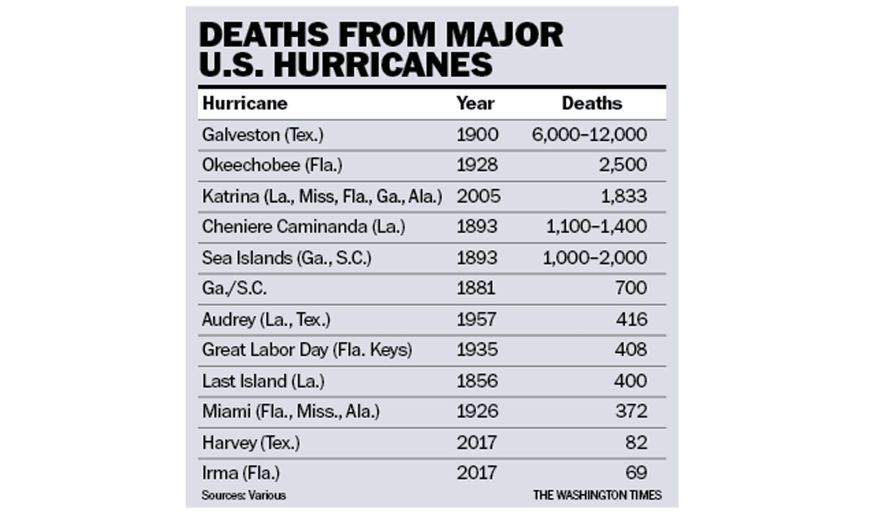Hurricanes Harvey and Irma were as powerful as the big South Florida hurricanes of 1926, 1928, and 1935, but the death toll was very small compared to the earlier hurricanes in the area, even though the population is now more than 10 times the size. The Great Galveston hurricane of 1900 is estimated to have cost 6,000 to 12,000 lives. The hurricanes that have hit the U.S. in the last 50 years have resulted in relatively few lives lost, with the exception of Hurricane Katrina where an estimated 1,833 died.
The reason so few people die now is the better forecasting, the development of weather satellites, and much better infrastructure. The Katrina disaster was not the fault of the weather forecasters but the fault of state and local government leaders to evacuate the low-lying areas in New Orleans, despite the urgings of federal authorities to do so, and neglected flood control levees and pumps. The Mayor of New Orleans, Ray Nagin, now sits in jail because of corruption rather than manslaughter — his bigger crime.
After Hurricane Andrew in 1992, Florida changed its building codes to require both much stronger buildings and living spaces be elevated many feet above expected floods. It is no surprise that most of the severely damaged homes were house trailers that are not designed or built for high winds and water.
The Florida Keys, at best, are only a few feet above sea level, and the Keys are often hit with hurricanes so it would be expected that most wood-frame low-lying structures will be destroyed or greatly damaged at least every few decades. A prudent person does not own such structures in the Keys unless one treats it as a disposable good like an old computer.
Since the end of the last ice age about 8,000 years ago, sea levels have been slowly rising at about 1/8 of an inch or 0.3 centimeters per year (i.e., a foot every 120 years). The rise in sea levels has been slow enough that it has been easy for mankind to adapt. Most buildings and infrastructure are rebuilt every 30 to 70 years, so building the new structures higher is done as a matter of course.
Despite the alarmism coming from some, there is no evidence that sea levels are rising faster than the historic rate (nor has the Arctic ice cap melted, nor has the Earth’s temperature risen at the rate forecasted by virtually all of the major climate models). However, a prudent person who intends to build on the Florida shore might well assume that the sea might start rising as much as three times the current rate, and build up an extra three feet (or one meter), but a foolish person might insist upon building at either the current level, or 50 feet higher which would not meet any reasonable cost-benefit standard.
(A personal note: For several decades, my parents owned a house on the water in Saint Petersburg, Florida. The house was built in the 1950s on sand about six feet above mean high tide, and it still stands, having never been flooded or severely damaged by hurricane winds. The old houses in the neighborhood are slowly being replaced by new concrete homes whose living quarters are about 18 feet or so above sea level — which is a prudent, not a foolish, bet that there is a very high probability at such a level it will not be flooded in the next 70 years.)
Provided the additional cost is modest, it is prudent to try to mitigate the increase in CO2 emissions, even though the current level is far below optimum for plant growth. It would be foolish to shut down all coal or other fossil fuel plants and try to depend on wind and solar or other intermittent renewables until economic batteries or other storage technologies are developed to avoid electric grid shutdowns. Such shutdowns would severely curtail economic growth and undermine the ability to improve lifesaving infrastructure, job creation, and higher incomes.
Closing U.S. coal plants will do nothing to curtail global warming given the world is adding new coal plants at a far faster rate than it is shutting them. For instance, China has 2,363 plants and is adding another 1,171 for a total of 3,534. India has 589 coal plants and is adding another 446 for a total of 1,035. The U.S. has 589 coal plants, but is reducing the number.
Life is all about accessing the probabilities of the risks and costs and benefits of alternative courses of action. It is prudent to create stronger structures to deal with climate change as mankind has been doing for thousands of years. It is foolish to spend billions or trillions of dollars to try to change the climate at the current state of knowledge. Better to adapt than tilt at windmills.
http://www.washingtontimes.com/news/2017/sep/18/hurricanes-teach-prudence-adaptation/
© Copyright 2017 The Washington Times, LLC.
